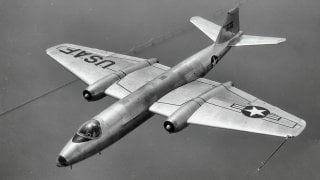The Martin B-57 Canberra Bomber Is Still Flying After 70 Years
The Martin B-57 Canberra, a twin-engine tactical bomber and reconnaissance aircraft, served for thirty years with the U.S. Air Force. But NASA still flies three B-57s, meaning the bomber, first flown in 1953, has been in service of some kind for over seventy years.
Summary: The Martin B-57 Canberra, originally a British design from the 1940s, was adapted by the U.S. for use as a twin-engine tactical bomber and reconnaissance aircraft.
-First flown in 1953, the B-57 has served for over seventy years, including thirty with the U.S. Air Force and ongoing use by NASA. It was the first U.S. jet bomber to drop bombs in combat, seeing extensive use in the Vietnam War. The aircraft also performed high-altitude reconnaissance and electronic warfare.
-After proving superior in performance during a crucial 1951 fly-off, it was adopted over other competing American models, marking a long service history.
Decades of Service: The Enduring Legacy of the Martin B-57 Canberra
The Martin B-57 Canberra, a twin-engine tactical bomber and reconnaissance aircraft, served for thirty years with the U.S. Air Force. But NASA still flies three B-57s, meaning the bomber, first flown in 1953, has been in service of some kind for over seventy years.
The B-57 Canberra is even older than that. Martin’s is a licensed version of the English Electric Canberra developed in Britain in the 1940s. The first American-made B-57s were carbon copies of the British version. Martin gradually incorporated American parts, making the aircraft more subtly distinct from its British parent as time passed.
The B-57 holds a special distinction in U.S. military history: It was the first jet bomber to drop bombs during combat. Used extensively as a bomber during the Vietnam War, a variant of the B-57, the RB-57D, was built to perform high-altitude reconnaissance and electronic warfare.
The United States exported its licensed bomber to the Pakistan Air Force, which used the aircraft during its wars with India in 1965 and 1971.
Developing the B-57
When the Korean War began, the Air Force recognized its lack of an all-weather interdiction aircraft. The Douglas B-26 Invader, with its piston engines, was used early in the conflict but had inadequate survivability and poor mission success.
The Air Force suspected that a relatively new British aircraft might be the answer, and in August 1950, the Royal Air Force demonstrated the Canberra bomber for a group of U.S. Air Force officials at RAF Burtonwood. After the demonstration and a series of follow-up test flights, the Air Force formally issued a request for a jet-powered bomber with the following abilities: top speed of 630 miles per hour; ceiling of 40,000 feet; range of 1,150 miles; full all-weather capability; and a secondary reconnaissance role.
American models competed, including the Martin XB-51, the North American B-45 Tornado, and the AJ Savage. However, in an effort to accelerate the process, the Air Force would only consider aircraft that already existed. This included foreign aircraft:, such as the Avro Canada CF-100 and the Canberra.
In order to be properly evaluated, the Canberra had to be flown to America. This was a significant feat—when it flew from the UK to Canada, it became the first jet aircraft to cross the Atlantic nonstop without refueling, doing so in a record time of four hours and thirty-seven minutes.
Once the Canberra arrived in America, the jet bomber was set against the four rival aircraft competing for the bid. In February 1951, the bombers participated in a fly-off from Andrews Field, with ten minutes apiece to demonstrate maneuverability and performance. The fly-off settled all doubt. The Canberra markedly outperformed the rival aircraft, effectively earning the bid in the process and setting the stage for 30 years of continuous service with the U.S. Air Force.
About the Author: Harrison Kass
Harrison Kass is a defense and national security writer with over 1,000 total pieces on issues involving global affairs. An attorney, pilot, guitarist, and minor pro-hockey player, Harrison joined the US Air Force as a Pilot Trainee but was medically discharged. Harrison holds a BA from Lake Forest College, a JD from the University of Oregon, and an MA from New York University. Harrison listens to Dokken.

